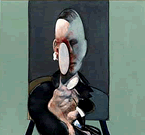|
|

•
•
•
•
•
•
•
•
•
•
•
•
•
•
•
•
•
•
•
•
•
•
•
•
•

|
|


In the painting “Vulture,” Francis Bacon presents his audience with three images of a man being attacked by vultures. By using these different images, Bacon attempts to reveal both the unifying mortality of man and the variety of the individual’s trappings. Essentially, he is identifying man as a member of a smaller community created by environment as well as the larger community of the human race. The message this image carries is ideal for my multi-cultural logo in that it addresses the unique identities created by an individual’s culture, yet reminds us that despite cultural differences, we are all one community facing many similar struggles. The complexity of the multicultural world is especially apparent in public education. Everyday, teachers struggle to reconcile the cultural differences within their classrooms in order to create an effective educational community. This requires the cultivation of trust, sharing, cooperation, and personal growth through mutual understanding within the educational community. When placed side by side, the differences between Bacon’s three vulture attacks gives the work its meaning and effect. It is, in fact, the interaction between the separate works that creates one larger piece. This is the model that school administrations should use for ensuring equity in governance and organization. Administrators should reach out to the various cultural demographics in their community for input on important issues. Each cultural group’s beliefs and suggestions should be equally considered by administrators when making critical decisions concerning school policy. Additionally, state officials should support equal funding for all school districts so that school administrators have the power to create an environment of equality in their schools. Equity in policy and funding is essential to creating a truly meaningful and effective educational system. The Power of TrainingAchieving multicultural equity within education starts with teacher training. It is easy for any art novice to notice differences between the three images of the “Vulture.” However, it takes careful study of the painting to fully realize the meanings of these differences and how they relate to work as a whole. Similarly, it easy for most new teachers or pre-service teachers to observe the physical differences in their students — e.g. short, skinny, dark-skinned, freckles. Most teachers are also able to identify emotional differences in students over the course of a school year. Simple observation, however, does not build a functioning educational community. Through teacher training, observation can be honed into a skill for understanding complex cultural communities. By learning the characteristics of different ethnic groups, teachers can proactively work to maneuver issues of race, ethnicity, language, and social class to improve student-to-student relations as well as teacher-to-student relations. Teachers should also receive training in effective assessment techniques of multicultural bodies of students. Sensitivity to differences between the social skills of varied cultures is imperative to creating a fair learning environment. Challenge the DogmaticEach of the three images in the “Vulture” present aesthetically different perspectives on the same event. For this reason it is impossible to grade the artistic skill of each image by using the same criteria. The center image is far more expressionistic than the others, so it cannot be graded by using realism. In this way, the stylistic ambiguity of the work challenges dogmatic methods of artistic assessment. Similarly, the dappled palate of the multicultural population of students in the United States cannot be graded using a rigid and culturally insensitive method for assessing student work. Assessing complex cognitive skills is a difficult job in itself. For this reason, teachers must know the cultural backgrounds of their students to ensure that assignments and assessments reflect the students’ cognitive abilities and not their social abilities. In this light, teachers must consider the cultural implications of certain assignments. For example, if a Muslim girl refuses to wear a school-mandated gym outfit because she is around boys, she should not fail gym class. It is the responsibility of instructors to amend the assessment criteria (i.e., wearing the school’s uniform) for the gym class, so the girl is given equal opportunity to participate in the class. Bacon’s painting can also remind educators that, just as each image contains distinct differences, every student’s home comes with different obstacles and amenities. For this reason, it is imperative that every child receive an education equal in opportunities, requirements, and expectations. The Unifying ContextThe continuity of the “Vulture” relies heavily on its common environment. Similarly, student learning demands educational continuity through a common school environment. The environment in this case envelops everything from geographical location to the demographics of the community and school. All instruction should help students develop skills for dealing with the societal environment in which they are living. Without the common background, the painting loses context and, hence, meaning. Without addressing the social, political, and economic environments in which students live, there ceases to be a unifying context for student learning. Knowledge of social context is a necessity for all students, but especially for students from other states, countries, and ideological backgrounds. This knowledge is important because it allows students an equal opportunity in (non) school activities that play a key role in developing interpersonal skills. These personal skills allow for positive multicultural relationships. Positive multicultural relationships are the backbone of the intergroup relations necessary for an effective learning community. Each of the three depictions in the “Vulture” share a common background. Additionally, there are other commonalities, such as the vulture, the use of the portrait technique, and what appears to be newspaper beneath the portraits. The similarities in the images signify the commonalities between all people. To create effective learning environments, students and educators must be able to see past apparent differences and embrace the principles held common between all people, such as compassion, charity, companionship, and freedom. In order to facilitate acceptance, educators must actively group and re-group students to maximize multicultural interactions in an environment that is safe. Opportunities for safe, anxiety-free multicultural interaction can help increase communal understanding and cooperation to improve the social skills necessary for students to interact with different genders, races, ethnicities, religions, and language groups. Students should be educated on the damaging effects of bias and bigotry in a society, which will only increase as diversity increases. Strong intergroup relations are the bonds in an effective educational community and a healthy society. Identity, Culture, HeritageBacon’s painting, in addition to embodying the fundamentals of effective multicultural education, also signifies my personal and professional views on culturally sensitive education. Bacon is a famous Irish artist; his works are viewed by the Irish people as national treasures. Being from Irish ancestry, I identify greatly with his works from a cultural standpoint. “Vulture” is a symbol of my own individual ethnic community and heritage. The initially repellent images of innards and deformed faces provide, upon further inspection, a positive message. From a professional perspective, I find in my initial revulsion and eventual acceptance a beacon for effective multicultural teaching. Many teachers fail to be effective educators because they lack cultural sensitivity and knowledge. “Vulture” embodies the idea that face-value perceptions are not meaningful in themselves. It is only through thorough examination that one can find the meaning in the work. Similarly, it is only through thorough study and observation that one can learn the cultural identities of the students in their classrooms. January, 2009
A is for Arkansas—
B is for boy,
C is for Catholic—
D is for Democrat—
E is for English—
F is for fish—
G is for growth,
H is for heritage—
I is for identity—
J is for justice,
K is for kids—
L is for the Loblolly Pine—
M is for middle class—
N is for Nationalism—
O is for open minded,
P is for potatoes—
Q is for quarks—
R is for resources,
S is for Seamus Heaney—
T is for 23,
U is for understanding
V is for vitality,
W is for Wyoming
X is for xenophobia,
"Y, as in y-chromosome?
Z is for Zen—
February 27, 2009
For a printer-friendly copy
For a printer-friendly copy
|
|
|


